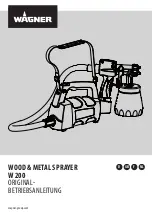
3
LEARN TO TRIGGER
Best results are achieved with the
™
by airbrushing with a good constant motion. Start motion
before pressing trigger, follow through motion after releasing trigger. Do not hesitate while spraying or you
will create what is called the Barbell Effect.
MAINTENANCE AND CLEANING OF YOUR AIRBRUSH
Careful cleaning and maintenance of your airbrush is essential if it is to continue to work effectively. The
small passages inside the airbrush can become blocked easily by dried paint if the airbrush is not cleaned
after each use. If there is still a useable amount of color in the color cup or reservoir when you have fin-
ished spraying, pour the remainder back into the original paint bottle. Operate the airbrush, spraying on a
scrap piece of paper until the color is gone and only air is sprayed. Take a clean color cup or jar full of
appropriate cleaner. Insert it into the airbrush, spray some cleaner through the airbrush at broad and small
patterns until it comes out colorless. After removing color cup or jar, turn the airbrush upside down and
press trigger. This will remove any material still in the airbrush. Always clean the airbrush every time you
finish spraying as some types of paint can dry remarkably fast, and may cause your airbrush to clog if not
cleaned properly.
Another method of cleaning the airbrush is back flushing using a closed container such as a jar assembly.
Take a soft cloth and cover the spray regulator – depress and pull back on the trigger. This will cause back
pressure which induces a bubble action inside the airbrush and in the container which helps to clean the fluid
passages. Never use an open color cup for this procedure as color will blow out. Take away the cloth and
spray and repeat this procedure several times. After this is done you should remove the needle for cleaning.
If the paint is allowed to dry inside the airbrush you may not be able to dissolve it with clean water.
Cleaning with solvent is the next step. If cleaning with solvent does not dissolve the blockage, you will
have to disassemble the airbrush, by first removing the needle and then the head. Soak the tip in warm
soapy water or appropriate solvent for ten minutes. Then take a tooth pick and gently remove the dried paint
from inside the fluid tip. This procedure may have to be repeated. Be careful during disassembly not to lose
any small parts.
REMOVING & REPLACING THE TIP
When replacing the paint tip (41-004), it is important to loosen the needle chuck (50-010) and partially
retract the needle (51-048). This will ensure that no damage will occur to the tip or needle as the head
assembly is tightened.
Unscrew the Spray Regulator (41-034), and Head (51-071). The tip can now be removed from its tapered
seat in the airbrush body (51-069). Make sure there is no dried paint on any part of the airbrush head or
body that could interfere with proper tip seating. Even a small amount of dried paint can cause tip mis-
alignment, which could lead to an uneven or pulsating spray pattern. Dried paint can be removed using a
moist cotton swab.
SURFACE
START
PRESS
PULL
KEEP STEADY
MOVE
RELEASE
FOLLOW
MOTION
TRIGGER
TRIGGER
MOTION
TRIGGER
TRIGGER
THRU
HERE
DOWN
BACK
AND SPRAY
FORWARD
MOTION
DON’T ARC
If airbrush motion in uneven,
paint finish will be uneven.
SURFACE
BUILD-UP
ARCING MOTION
THE MOST COMMON PROBLEM
Runs and sags are caused by one or more of the
following errors.
1. “Freezing” or forgetting to release trigger at the
end of the stroke.
2. Holding airbrush still or moving too slowly.
3. Holding airbrush too close to surface.
onto. A fine line or small dot is achieved by working very close to the surface while releasing a very
small amount of paint. A broad spray pattern is achieved by moving the airbrush back from the work
surface and pulling back further on the trigger to release a larger amount of paint. The proper
mechanics for triggering the airbrush are – press down to start air flow, pull pack to begin and
increase paint flow, push forward to lessen or stop paint flow, release (or up) to stop air flow.


























